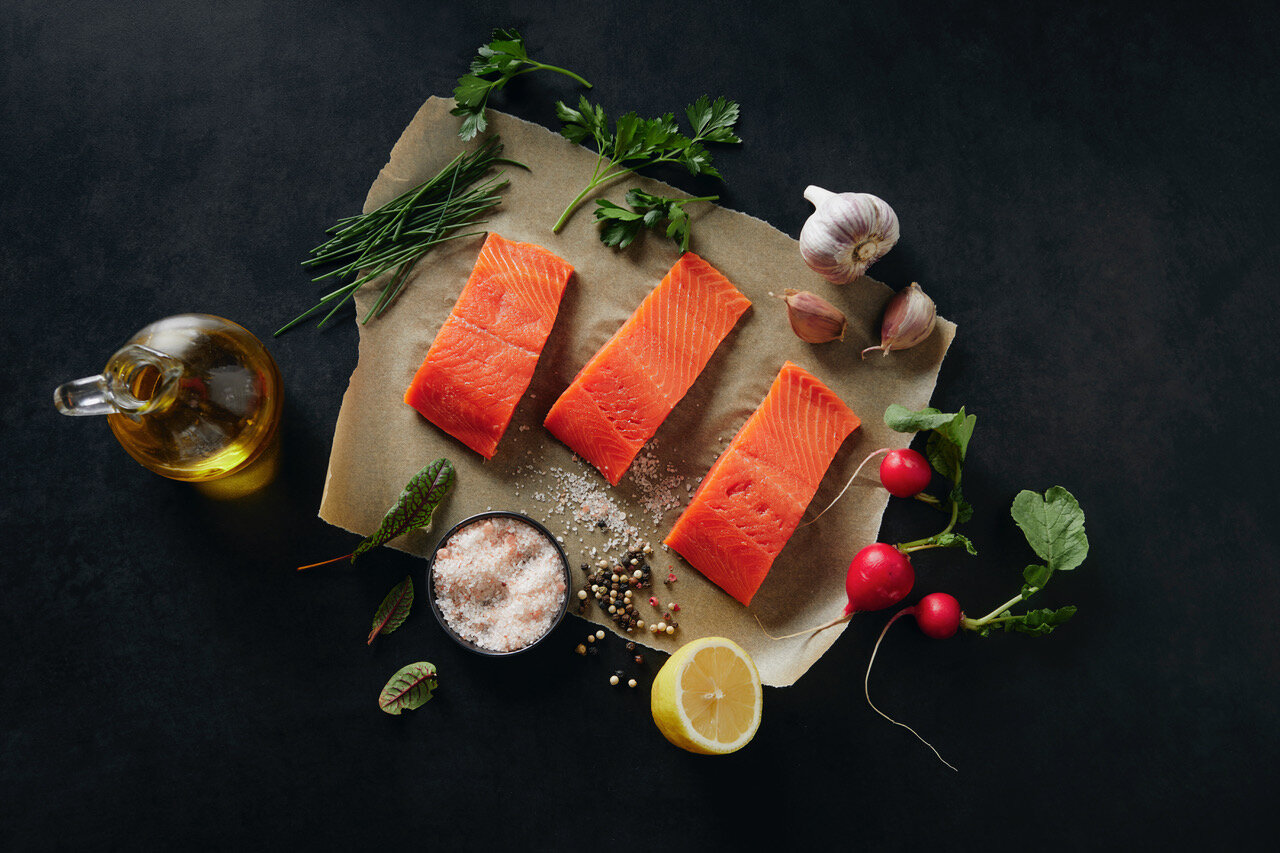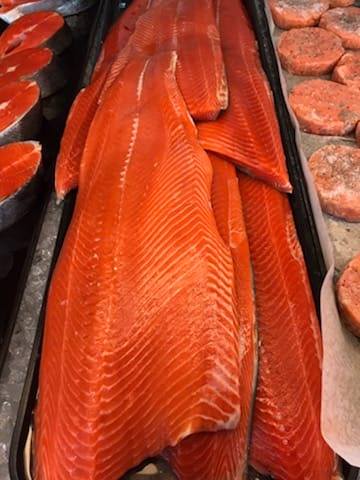
Buying & Storing
To make sure that you are buying a superior wild BC salmon product and then maintaining its top quality at home, follow these tips:
Photo credit: 1 Fish 2 Fish Market, Langley BC
BUYING TIPS
When buying wild BC salmon, look for:
bright, clear and shiny eyes
reddish gills
moist skin
shiny, tightly-adhered scales
firm, moist and translucent flesh that isn’t watery
a clean and sweet smell
a firm body that passes the pressure test – fresh salmon flesh will give slightly when you press it with a finger and then spring back into shape
Avoid buying wild BC salmon that:
has dried out flesh
has bruises or spots
is sitting in a puddle of liquid
smells “fishy” or objectionable
When buying frozen wild BC salmon:
Check the surface for signs of ice crystals or frost inside the wrapping and for any dried, cottony patches which indicates “freezer burn”.
Ensure that the plastic covering or vacuum packing are intact.
If the fish is glazed (coated in layers of ice), ensure that the ice coating covers all surfaces.
CUT & QUANTITY
There are many different cuts available as illustrated below. Simply choose the cut that best suits your recipe and quite often, the recommended cut will be noted right in your recipe. Remember, a little salmon goes a long way because very little of what you buy is going to cook away during the preparation. Use this guide to calculate how much salmon to buy.
Dressed
Gills and entrails are removed. 350 g (12 oz) per person
Pan-Dressed
Head, tail, fins and scales removed. 175 g – 250 g (6 oz) per person
Steaks
Cross-section slices of a large salmon. 175 g – 250 g (6 oz) per person
Fillets
Pieces cut from the sides. 175 g (6 oz) per person
Pieces or Chunks
Salmon centre section. 175 g (6oz) per person
STORING TIPS
Storing Fresh Wild BC Salmon
Follow these simple steps to best store your fresh wild BC salmon and to maximize its shelf life. Unwrap the salmon, and gently pat dry. Put two or three slices of lemon on top of the fish and wrap tightly in plastic wrap. Store the fish in the bottom of the refrigerator for up to two days.
How long will fresh wild BC salmon keep?
While under the very best conditions salmon will keep up to ten days after harvest, we recommend purchasing the fresh fish the same day or the day before you plan to serve it. Properly wrapped and stored fresh wild BC salmon will keep well in a home refrigerator for up to two days. Cooked fish can be stored for up to three to four days.
Tip:
The lower the temperature you can keep the fish at, the longer it will keep.
When buying wild BC salmon, bring a cooler and ask your fishmonger or fisherman for some ice so that you can store your salmon below 4° C (40° F) on your way home.
Never eat fresh salmon raw! In any cured or raw salmon dish, fresh wild BC salmon should first be frozen for 48 hours then thawed; alternatively, purchase previously frozen or FAS (frozen-at-sea) wild BC salmon.
Storing Frozen Wild BC Salmon
Keep your properly wrapped frozen salmon in the coldest part of the freezer directly against the freezer floor and wall and furthest away from the freezer door lid so that it receives the least amount of exposure to warmer air when the freezer if opened. Be sure not to re-freeze salmon if it has been allowed to partially thaw.
How long will frozen wild BC salmon keep?
Properly wrapped and stored wild BC salmon will keep well in a home freezer for about two months or three to four months in a deep freeze. If vacuum sealed, product will keep for 3 to 4 months in a home freezer and 6 to 12 months in a deep freeze. After that its flavour and nutritional value will start to deteriorate.
Freezing wild BC salmon
If you want to freeze your fresh wild BC salmon, be sure to start with the freshest high-quality salmon possible and use any of the following methods which keep the moisture in and the air out. If you are starting with a whole salmon, make sure that it is rinsed clean of blood and viscera before freezing. If you are freezing portions, package steaks and fillets individually or layer them with waxed paper in between for easier separation. Whichever freezing method you choose, be sure to keep your salmon in the coldest part of the freezer – directly against the freezer floor and wall and furthest away from the freezer door or lid so that is receives the least amount of exposure to warmer air when the freezer is opened.
Tips:
Keep fish frozen at a constant temperature of -18°C (0°F).
Smaller packages freeze faster and better than larger ones so consider dividing a large fish into portions.
Never freeze salmon that has been previously frozen.
Layer Wrapping
Wet the salmon, wrap tightly in plastic wrap, wrap again with foil, and then freeze. Or, completely wrap the fish in paper towels then thoroughly wet the towels with cold water. Wrap the fish in two layers of newspaper and completely wet the newspaper with cold water. Finally, wrap the entire “package” in heavy aluminum foil and then freeze.
Storing in Heavy Plastic Self-Sealing Bag
Wet each fresh salmon portion, place in a heavy plastic self-sealing bag and seal with all air removed. You will prevent freezer burn by making sure the bag is air-tight so push or suck all the air out before sealing the bag and then place in the freezer. Vacuum-sealers are a good investment to use this method.
Milk Carton Method
Place fresh salmon portions in a milk carton (or heavy duty freezer bag), fill with water, seal so the container is air-tight, and then freeze.
Glazing
Freeze fish as quickly as possible by placing fish portions (ie. steaks, fillets) on a cookie sheet, cover with wax paper or foil, and place in freezer.
When fish is solidly frozen, quickly dip each portion into a container of ice-cold water so that it is completely covered. An ice-coating will automatically form.
Place the portions back in the freezer uncovered for another 10 to 20 minutes.
Repeat dipping and freezing procedure about 5 or 6 times until a thick glaze, about ½ cm (1/4 inch), has formed. Wrap the salmon portions air tight in heavy plastic freezer wrap, or seal in a heavy plastic self-sealing bag and place in the freezer.
THAWING
When ready to use your frozen wild BC salmon, you can thaw it a few ways:
To thaw slowly, unwrap the salmon, place it in a pan, cover and leave for 24 hours in the refrigerator.
To thaw a whole fish faster, place the fish in a sink with cold running water allowing about ½ hour thawing time per 500 g (1 lb).
An even faster method is to defrost the fish in the microwave allowing 2 to 5 minutes per 500g (1 lb), followed by equal standing time in between zaps.

